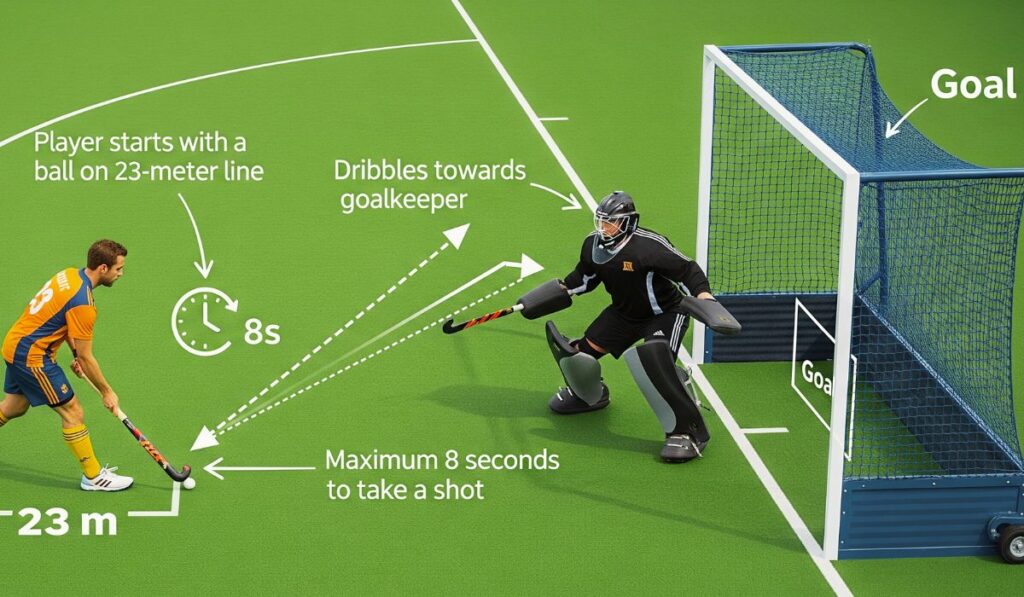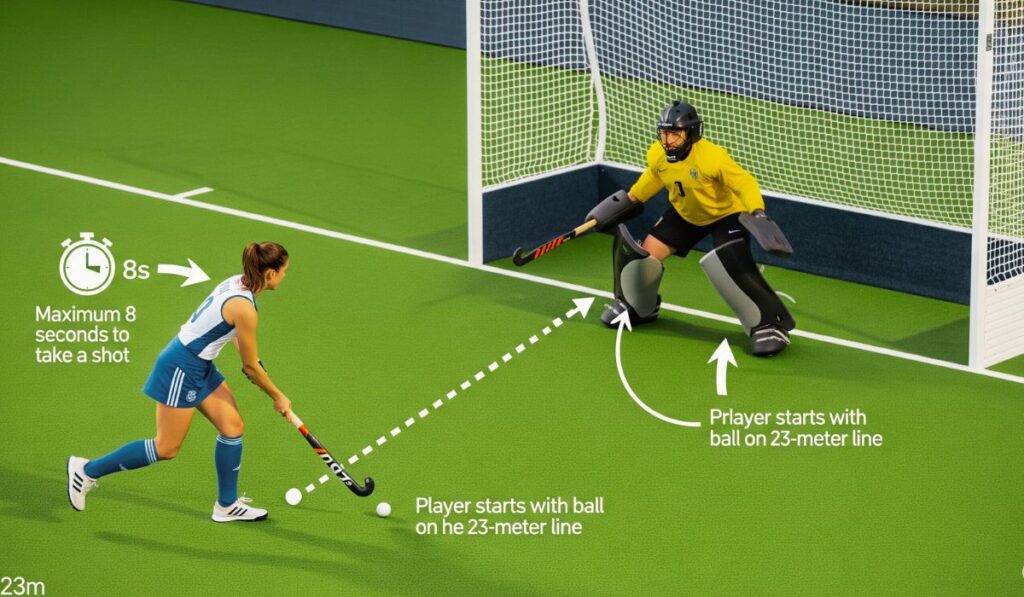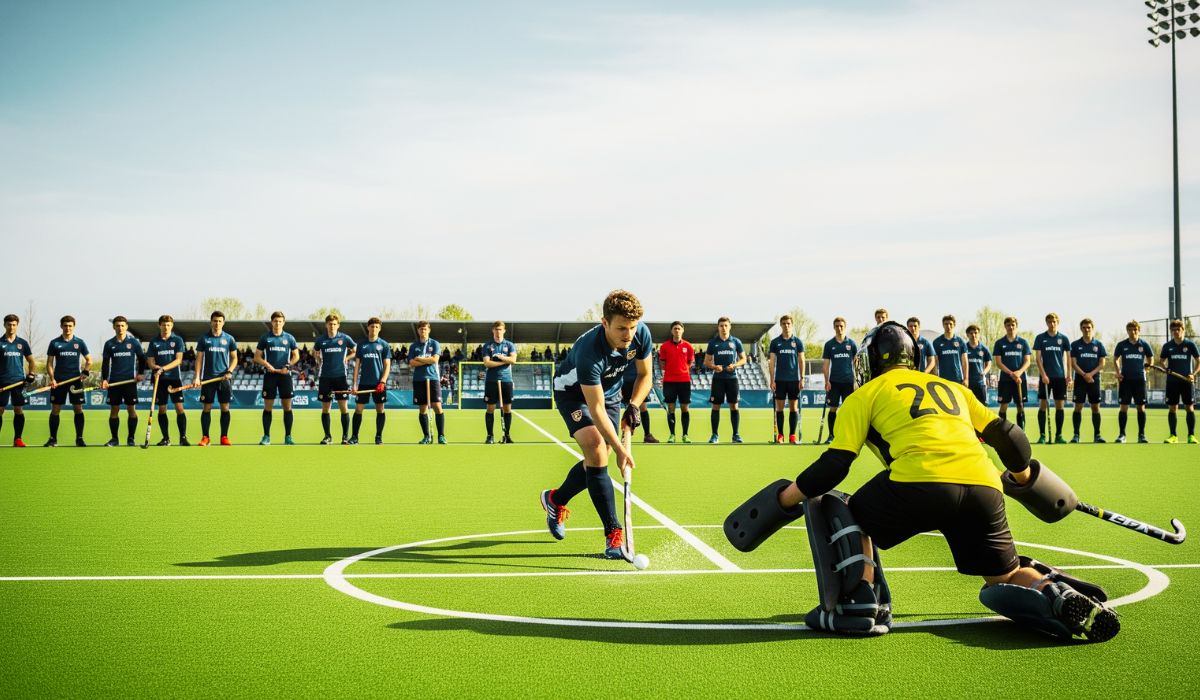“Hockey Penalty Shootout Rules Uncovered: The Brutal Reality That Crushes Some and Crowns Others”
When the clock runs out and both sides are locked in a draw, the stadium falls silent, hearts pound louder than the drums in the stands, and the spotlight shifts to the most nerve-wracking moment in hockey — the penalty shootout. For players, it is not just a test of skill; it is a dance with destiny. For fans, it is a rollercoaster of dread and delight, where one flick of the stick can transform tears of despair into tears of triumph. This is the stage where hockey penalty shootout rules come alive — rules that can crush dreams in an instant or etch names into eternal glory.
The Pulse of a Penalty Shootout
The Hockey penalty shootout rules is unlike any other part of the game. In regulation time, players rely on teamwork, passing, and structure. But in a penalty shootout, everything comes down to a single player and a single goalkeeper. The hockey penalty shootout rules strip away the noise and distractions and leave the raw essence of the sport: nerve versus nerve, instinct against instinct. As the forward sprints from the halfway line, stick tapping rhythmically on the turf, the entire stadium feels the electricity in the air. It is not just a shot at goal — it is a shot at immortality.
When Rules Shape the Drama
What makes Hockey penalty shootout rules so gripping is not just the skill but the strict rules that frame them. Every second is counted, every movement scrutinized. Players start from the center mark and have only eight seconds to attempt their shot. Unlike open play, there is no safety net of teammates to pass to, no chance to recover from a mistake. The rules dictate that once the whistle is blown, the striker must move forward, controlling the ball with precision while keeping their mind steady against the pressure of thousands watching. This ticking clock creates a tension that words can barely capture, a countdown that seems louder than the crowd itself.
The Keeper’s Staring Contest
For the goalkeeper, the hockey penalty shootout rules transform them into a warrior standing alone in the storm. They must remain behind the goal line until the striker begins their run. They cannot charge recklessly or cut corners; they must balance aggression with composure. The rules allow them to move out once the striker advances, but every step they take is a gamble. Do they rush forward to cut the angle, or wait patiently, hoping the striker hesitates? The keeper’s decisions, measured in split seconds, often determine the fate of the game.
The Striker’s Burden
The striker carries the heaviest weight of all. Imagine running up from the halfway line, knowing your teammates, coaches, and country may remember you forever based on this one moment. The hockey penalty shootout rules force the striker to juggle creativity with control. They can dribble, fake, twist, and turn, but they cannot stop moving forward or let the eight-second clock expire. A stumble, a moment’s hesitation, or a strike too wide could spell heartbreak. Yet, when executed perfectly, a flick into the top corner or a calm push past the keeper feels like poetry written in motion.

The Role of Nerves in the Rules
Though the Hockey penalty shootout rules may seem straightforward, the hidden layer is psychological. A player who freezes under pressure or a goalkeeper who guesses wrong loses more than a point — they lose their composure, their aura, sometimes their legacy. The rules are simple: move forward, stay within the time, no illegal tackles from the keeper. Yet it is precisely this simplicity that makes the drama so overwhelming. There is nowhere to hide, no second chances.
Fouls and Consequences
Of course, the rules are not only about scoring and saving. They also punish mistakes. If the striker commits an infringement — like shielding the ball illegally, failing to keep forward motion, or taking too long — their attempt is canceled. If the goalkeeper fouls, such as tackling illegally or intentionally obstructing outside the allowed moves, the striker may be given another chance. These clauses in the hockey penalty shootout rules add another layer of intensity, because every action, every decision, has consequences written in ink.
The Seductive Beauty of Silence
Perhaps the most haunting aspect of a penalty shootout is the silence before the strike. The striker hears nothing but the sound of their breath, the soft roll of the ball against the turf, and the distant whistle of the referee. In that moment, the hockey penalty shootout rules hold them captive. No crowd can save them, no referee can ease the tension. The silence becomes almost seductive — terrifying yet intoxicating, like standing on the edge of a cliff with the wind pushing against your back.
When Rules Break Hearts
Every fan remembers moments where their favorite player stumbled, their hero missed the target, or the keeper guessed wrong. The cruelty of the hockey penalty shootout rules is that they leave no room for excuses. If you miss, you miss. There is no debate, no controversy, no replay to lean on. These rules break hearts, leaving players shattered on the turf while opponents erupt in joy. Yet it is this cruelty that makes the victories sweeter, the successful penalties more unforgettable.
Triumph Within Boundaries
But just as the rules can destroy, they can also elevate. When a striker dances past the keeper within the eight-second rule and slots the ball home, the stadium erupts like a volcano. When a keeper dives the right way at the right moment, following the Hockey penalty shootout rules to perfection, they become legends overnight. The rules of the hockey penalty shootout create a stage where discipline, composure, and brilliance come together. Without these boundaries, the magic of these moments would fade.
The Power of Practice
Behind the glamour and heartbreak lies endless preparation. Players rehearse within the framework of the Hockey penalty shootout rules over and over again. Coaches time their strikers, remind them to stay in forward motion, and drill goalkeepers on what is permissible in tackles and positioning. This rehearsal gives the drama of the hockey penalty shootout its sharp edge. Every step, every strike, is rehearsed not just as a skill but as obedience to the rules.
Shootouts as Storytelling
In many ways, the hockey penalty shootout rules are not just guidelines for play — they are scripts for stories that will be told for years. They dictate the pacing of the drama, the rise of tension, the climax of the shot, and the resolution in either agony or ecstasy. These rules write the narrative of international finals, school tournaments, and Olympic dreams. They ensure that what happens in a penalty shootout is never forgotten.
The Weight of Every Step Towards the Goal
When a player begins that lonely walk towards the penalty spot, the world seems to hold its breath. Each step feels heavier than the last, as if gravity itself is testing the willpower of the player. The crowd roars, yet the sound fades into a haunting silence within the athlete’s mind. This is not just a Hockey penalty shootout rules-bound moment in hockey—it is a raw human trial where courage, focus, and instinct collide.
Understanding the Core Rule of the Shootout
At its essence, hockey penalty shootout rules are deceptively simple: one attacker, one goalkeeper, and a few short seconds to determine glory or despair. The attacker has the right to dribble, feint, or strike, but all within a carefully regulated time frame. The goalkeeper, meanwhile, must balance aggression with discipline, stepping forward without overcommitting. These Hockey penalty shootout rules are designed not merely for fairness but to intensify the drama, to compress the vastness of a match into a fleeting heartbeat.
Why the Penalty Shootout Exists
Hockey penalty shootout rules in hockey were introduced to break deadlocks, ensuring that matches—especially in tournaments—never end in uncertainty. But beyond practicality, they embody a test of nerve. A team’s months of training, strategy, and sacrifice can be distilled into a handful of one-on-one battles. The rules transform a team sport into a duel of wills, exposing vulnerabilities and amplifying strengths.
The Countdown: Time Limits That Crush or Create Heroes
One of the most nerve-shattering Hockey penalty shootout rules is the strict time limit, often set at eight seconds. Within those seconds, a player must glide forward, calculate the goalkeeper’s stance, disguise intentions, and unleash a shot with surgical precision. To the audience, it feels like an eternity. To the player, it vanishes like a puff of smoke. The time rule injects urgency, forcing athletes to marry instinct with control.
Goalkeeper Restrictions: The Dance of the Last Defender
For goalkeepers, the rules are equally ruthless. They may step off the line, but they cannot overstep boundaries too soon, or their move risks invalidation. Their gloves, pads, and stick become shields of hope, but they must resist lunging too early. This delicate balance between patience and aggression makes the goalkeeper’s role during a Hockey penalty shootout rules as psychological as it is physical.
Attacker’s Freedom—and Its Burden
Unlike older formats, modern hockey shootout rules allow attackers to dribble rather than only hit from a fixed spot. This freedom opens a theater of creativity: drag flicks, sudden stops, subtle body feints. Yet freedom carries its own weight. Too many options can paralyze the mind, and hesitation becomes a silent thief of victory.
The Rule of Fair Play
Shootouts are governed by a strict code of conduct. Any infringement—such as obstructing unfairly or misusing equipment—leads to disqualification of the attempt. These fairness rules remind players that while shootouts thrive on emotion, the backbone of hockey remains discipline and respect.
The Sensory World of the Shootout
Imagine the sharp chill of the turf under a player’s shoes, the sticky grip of the stick handle against sweating palms, the echo of breath beneath a helmet. For the goalkeeper, there’s the thud of the ball against pads, the sting when it clips a finger, the rush of adrenaline when a save earns a roar. These sensory fragments, magnified by pressure, make every rule not just a guideline but an emotional stage for human fragility and triumph.
Crowd Influence and the Rules of Silence
While the rules are written on paper, the crowd’s presence rewrites them in spirit. Every shriek, gasp, and chant seeps into the veins of the player. There are no written laws about how a player must ignore this energy—but mentally, it is the greatest unwritten rule. A true champion obeys the game’s regulations while mastering the invisible ones imposed by atmosphere.
The Heartbreak Rule: Misses That Echo Forever
Perhaps the most devastating aspect of hockey penalty shootout rules is their unforgiving nature. One missed attempt is final; no second chance exists. For a player who falters, the echo of that moment can last a lifetime. For the victor, the same rule crystallizes glory into immortality.
Rule Evolution and Its Impact
Over time, Hockey penalty shootout rules have evolved to heighten fairness and excitement. From static strokes to dynamic dribble-ins, the transformation has brought unpredictability and artistry. This evolution reflects the sport’s attempt to balance logic with drama, ensuring that shootouts remain the most electrifying climax in hockey.
When Rules Meet Psychology
Beyond whistles and regulations, the Hockey penalty shootout rules is a game of nerves. The rules provide structure, but psychology determines the outcome. A player who bends the goalkeeper with a stare, a keeper who intimidates with silence—these unspoken duels exist within the framework of formal rules, making each contest layered with emotion.
Seduction of Risk in the Rules
Penalty shootouts seduce players into risk. Go for a cheeky chip? Attempt a deceptive spin? Or play it safe with a low push? The rules permit creativity, but they also punish hesitation. This seduction, the lure of brilliance, often decides whether a player becomes a highlight reel or a forgotten footnote.

The Equalizer Rule
Shootout rules are designed to give both teams equal attempts, removing bias. Yet within this fairness lies a cruel twist: equality does not ease pressure. Instead, it sharpens it. Knowing that your rival also has a shot can magnify the weight of your own attempt.
Glory in Obeying the Rules
What makes hockey penalty shootout rules so magnetic is how they transform ordinary players into legends. When an athlete follows every restriction, yet finds a way to shine under them, the brilliance feels earned, almost holy. These rules, instead of suppressing players, create a canvas for artistry under pressure.
Sensory High After a Goal
When the ball finally slams into the net, the release is primal. The metallic rattle of the cage, the vibration of the turf, the explosion of cheers—it’s a sensory flood that drowns out exhaustion and fear. In that instant, every suffocating rule feels like it existed only to amplify the sweetness of triumph.
Defeat: The Bitter Taste of Rules Enforced
For the one who misses, the taste is bitter, almost metallic. The head drops, the body feels heavy, and every detail of the miss replays endlessly. The rules permit no excuses, no redos. That is their cruelty and their honesty—they expose failure in its rawest form.
How Fans Interpret Rules Through Emotion
While officials enforce penalty shootout rules clinically, fans interpret them with emotion. To one side, they are chains holding back destiny. To the other, they are the crucible that proves greatness. This dual perception adds layers of passion, making shootouts as much about storytelling as sport.
Legends Born Through Rules
Every era of hockey has its icons who thrived under shootout rules. Their names live on because they mastered the most punishing test of all. Their courage, their precision, their poise—these live as proof that rules, rather than limiting, can elevate.


1 thought on “Hockey penalty shootout rules”